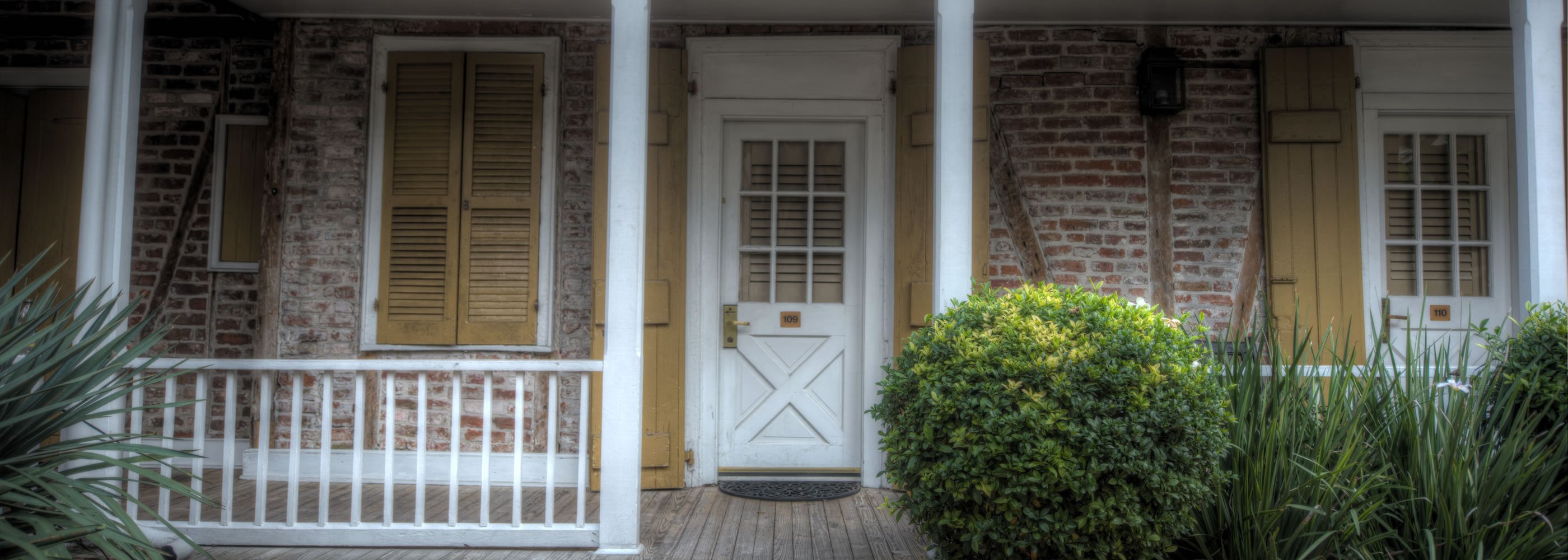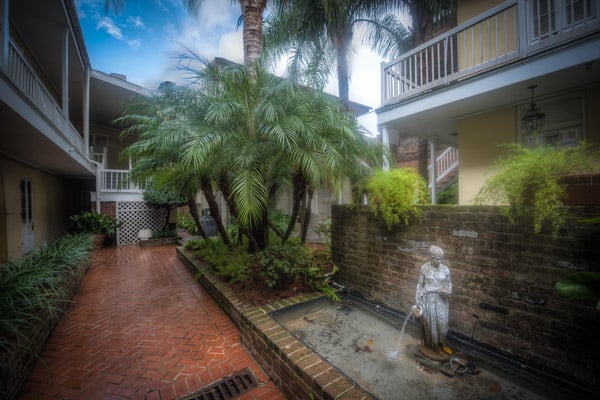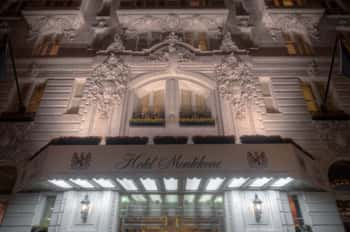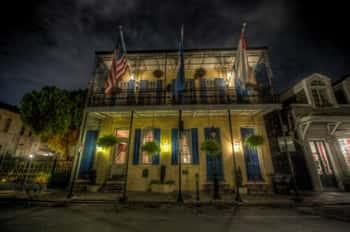


Only one block away from the notorious Bourbon Street sits the Dauphine Orleans Hotel. In the quiet of the night, the sounds of trumpets blowing and laughter are a distant memory of Bourbon nightlife for those heading back to the Dauphine Orleans. Passing the infamous May Baily's Place, Dauphine Orleans’ lounge and bar, guests enter inside the hotel at 415 Dauphine.
Once inside, the boisterous noise from the street fades away to nothing more than an imprint of an echo.
The Dauphine Orleans Hotel is an oasis located in the heart of the French Quarter. Courtyards open into yet another courtyard; overhead, balconies provide guests with much appreciated outdoor space.
With over one hundred guest rooms, this hotel encompasses rooms and property on either side of Dauphine Street. You read that correctly: both sides of the street. It’s no wonder that the Dauphine Orleans is routinely considered to be one of New Orleans’ finest and most luxurious hotels, offering each guest that perfect experience suited just for them.
Want to stay in your standard suite? The main building is for you.
Are you looking for something a little more secluded, perhaps even for a group vacation? Look no further, the Cottages or the Hermann House Guest Rooms may be more your speed.
Maybe, just maybe, you’re looking to spice things up during your vacation to New Orleans? You might have to reserve your room some months in advance, but lo and behold, the Bordello Suite above May Baily’s will be yours to call home during your stay.
(Did I mention that May Baily’s was once a licensed brothel during the nineteenth century?)
This elegant hotel winds together timeless beauty and modern amenities to create an experience guests won’t soon forget.
And if you’re looking for ghosts? Look no further: the Dauphine Orleans Hotel is considered one of the most haunted Places to Stay in the Big Easy.
The history of the Dauphine Orleans’ plot of land extends all the way into the late eighteenth century when it was owned by some of New Orleans’ most influential first families.
Don Andres Almonester y Roxas reportedly owned it a “long, long time ago” (yes, it says this exactly in the notarial records), presumably around the 1780s when he owned and operated most of the real estate in the French Quarter. During this period, Don Almonester donated a portion of the land to Charity Hospital. Colonial New Orleans can be summed up in just a few, scant words: “disease ridden” and “a convoluted mess.” A hospital which targeted all citizens of the city, without excluding anyone on the basis of color or sex or status, was integral for the overall health of locals and foreigners alike.
It was after Charity Hospital sold the land that the plot of land surrounding 415 Dauphine came to be owned by many other wealthy families. Within the next few decades, the Chauvins, Broutins, Trepagniers and Bonabels had all touched or owned this property.
(Fun Fact: From 1808 to 1811, the property was owned by Augustin Macarty, who was either Madame Delphine LaLaurie’s cousin or uncle, as the records are unclear as to which Macarty generation it was. Also, yes, I’m referring to that Delphine LaLaurie).
After 1815, 415 Dauphine fell into the hands of Joseph Forneret, who owned the property next door, and who also happened to be a free person of color.
Samuel Hermann, Sr., was not born in Louisiana. He was a native of Rodelheim, Germany, born in 1777, but like many Europeans during this period, saw the Louisiana colony as an opportunity for a endless fortune.
After moving to Louisiana, Hermann settled some twenty miles up the Mississippi River along the Des Allemandes, or the German Coast. He married Louisiana-born Marie Emeranthe Becnel, of the incredibly prosperous Becnel family, and got to work on making that fortune which had so enticed him from his German homeland.
Hermann, it appears, had a knack for investment. He worked as an agent and broker for plantations—he did so well that he moved his family to New Orleans in 1813. When he commissioned architect William Brand to build him a home in 1831, Hermann knew exactly what he wanted.
Federal Style in architecture, he wanted that. Oh, and “the best country brick, sand and cypress?” Hermann was unwilling to forego this particular luxury. His particularity transcended all the way to the size and style of nails and “the number of coats of paint he required.” Hermann wanted only the best.
(Recent renovations to these cottages unveiled that the nails were purchased from Lafitte's Blacksmith Shop on Bourbon).
Unfortunately, Hermann’s grand plan for prestige and mass fortune spiraled in a drastic decline after 1837, when the English Cotton Market crashed. This incited a flare of worldwide panic, in which Samuel Hermann, Sr., eventually lost his beautiful home to another. Hermann, his wife and youngest daughter continued to live in the French Quarter until his and his wife’s death in the 1850s.
Today, the Hermann home is actually known as the Hermann-Grima House Museum. The front of the house, and the museum, is located on neighboring St. Louis Street, while the Dauphine Orleans Hotel owns the back carriage house and old stables that once configured the entire Hermann property.
It was in 1857 that May Baily’s Place opened. Technically referred to as a “sporting house,” May Baily's was a brothel or bordello. Same thing, different title. All sorts of terms were used during this period, including (but not limited to) a house of ill-repute, parlor house, den or crib.
None, in the year 1857, were deemed legal. This section of the French Quarter was heaving in ladies of disrepute. Men paid anywhere between five and twenty-five dollars to visit a prostitute; if the man hoped to spend the night, he was looking at a bill that tipped toward the fifty-dollar mark.
May Baily entered the prostitution business by necessity, if not desperation. In 1847, her father was one of the thousands of victims consumed by the deadly yellow fever epidemic. May, seeing no other recourse, approached her father’s friend for help: she wished to open a “sporting house” on Dauphine Street but needed assistance. The friend agreed, no doubt tempted by the lucrative cash the brothel would bring in, and May’s Place opened its doors in 1857.
But May had something that many of the other houses of ill-repute did not.
Under the “Ordinance Concerning Lewd and Abandoned Women,” May Baily’s sporting house was gifted a city license, legalizing all the activity that occurred there within.
May’s girls provided entertainment for the gents who waltzed through the front doors of her ca. 1820 French Creole cottage. It’s doubtful that any of the men regretted their decision, though May’s younger sister Millie resented being employed within the Red-Light District.
Nevertheless, May’s Place was a staple within the French Quarter and it remained so even when that section of town was formalized into Storyville, a legalized social reform movement to quarantine all brothels into a 38-block radius in 1897.
Today, May Baily’s City Ordinance License is displayed proudly within the lounge, along the back wall, for all to see. Encased in a dark frame, the license is crinkled with age, but the black ink remains crisp and legible.
(If you want to read more about Madame Baily, check out this article!).
While Madame May Baily was prospering, life on the other side of Dauphine Street was . . . Well, it was a struggle.
92-98 Dauphine (now 416-430 and part of the Dauphine Orleans Hotel Collection) was known as The White Elephant during the mid-to late nineteenth century. Like much of this section town in that period, The White Elephant was a prostitution house, better referred to as a “den.”
And the ladies of the night who worked in these dens? They had none of the class or manners that May Baily reportedly wielded. These women, Nellie O’Neal and Eliza Riddle among others, were notorious thieves and pickpockets, prone to violence.
The Times-Picayune, then the Daily Picayune, is littered with numerous charges labels against them, none of which are particularly flattering. They do, however, paint a vibrant picture of Dauphine Street and the encompassing blocks.
Many prostitutes were desperate for funds, desperate for cash, desperate for survival. Willing to do whatever necessary, these women of ill-repute were known to stand in their doorways and lure men in off the streets. Beating them, robbing them; these men would sometimes end up dead (buried in the courtyard of the den) or released, but stripped off all of their personal belongings.
Some of these women were legends, even amongst each other. Eliza Riddle, who worked as a prostitute at The White Elephant before its closure, was the sort of woman who would have frightened even the bravest of souls.
From 1881 to 1896, Eliza Riddle was arrested a total of twenty-four times. She spent ten years at the Louisiana State Penitentiary for robbing one man of a grand $500 while he visited The White Elephant. Even while in prison, Eliza Riddle’s sentence was lengthened because she’d convinced male friends to help her escape. The plans didn’t work—and the men got jail time for their troubles—but Eliza was back at it, hitting the streets, the minute she inhaled the fresh air.
On 11 November 1882, a newspaper article titled “A Bottle Battle” described a brawl between Eliza Riddle and Virginia Reed, another prostitute. Not to be outdone, Riddle struck Virginia Reed with a bottle in the head, drawing blood. This was not Eliza Riddle’s only foray into using dangerous weapons in the midst of a fight; bottles were used in other transgressions, and so was a lamp.
One reporter for the Times-Picayune described her as “one of the worst creatures on Dauphine Street."
Her so-called protege, Nellie O’Neal, who had also done time for larceny, was arrested for stealing $12 from a gent at the White Elephant, the Dauphine Street den. When police officers arrived on the scene to arrest her, Nellie O’Neal attempted to scratch the officer’s face and gouge out his eyes. (The author of the article then helpfully opined that he believed O’Neal would be visiting Eliza Riddle at the State Penitentiary soon enough).
The 38-block radius of Storyville and its predecessor was a dangerous place, where women like Eliza Riddle and Madame May Baily may have worked directly across the street from one another, but lived completely different lives.
Today, the Dauphine Orleans Hotel now owns both of these properties. While May Baily’s past history as a bordello is well-known, the history of The White Elephant, now the Hermann House Guest Rooms, should not be forgotten . . . And one question remains: Which section of this hotel will you choose to stay?
The Dauphine Orleans Hotel opened in 1969, and since that time has gained international acclaim for its elegance and timeless nature. Kim Majoue, the hotel’s Sales Manager, was kind enough to bring Ghost City Tours around the hotel for an insider’s view.
Her favorite spot in the hotel? “May Baily’s,” she told us. She also enjoys the back courtyard, where most of the weddings are held at the hotel. It’s a private space, enclosed by the back of May Baily’s, with a serenity unexpectedly found within the boisterous French Quarter.
For Majoue, the highlight of the hotel is its wonderful staff and service. Many of the employees have been with the hotel for twenty or thirty years, and the Dauphine Orleans prides itself on its “genuine service.”
This history of this location seeps through the walls everywhere; in the Audubon Room, where breakfast is now held, but was where John James Audubon painted his Birds of America series from 1821-1822. On the exposed cypress beams of the cottages; and the exposed brick within the Herman House.
Staying at the Dauphine Orleans Hotel is like visiting a time long forgotten, but the ambience and presence of the hotel bridges that centuries-wide gap.
. . . Some of those century-old inhabitants of the property have simply never left, and enjoy making their ghostly presence known to the hotel’s employees and guests.
Who exactly is haunting this historic hotel? Management and guests alike have a sneaking suspicion that the ghosts wandering the grounds were once visitors of Madame May Baily herself.
It makes sense, does it not, that some of the guests who visited May’s Place in life might choose to stick around after death? After all, they still might be looking for a rowdy good time . . .
While May Baily ran this fine establishment, her younger sister Millie allegedly hated everything that the fine bordello stood for: subjugation to a life with little choice.
Millie Baily wanted more. In a venue where the satisfaction of the visiting johns was integral to keeping the business afloat, Millie wanted nothing to do with the red-light district. As the story goes, Millie got her chance to escape the sordid life she’d always known in 1861, when she met a nice Confederate soldier. Against all the odds stacked against the couple, they fell in love and Millie’s beau proposed.
Finally, she must have thought giddily, as she prepared for her wedding.
Her happiness was short-lived.
On the very day of the wedding, Millie’s betrothed was shot dead. Gambling was the cause; the brawl that took her young soldier’s life, the end result. Her wedding dress that she had sewn so meticulously, caressed so lovingly, never made it to the altar, although Millie apparently took the opportunity to wear it around the sporting house whenever she could.
Today, guests have spotted Millie’s ghost in her lace wedding gown standing forlornly near May Baily’s, as if still half-hoping that her loved one might return for her.
Guests have reported seeing the spirit of a man dressed in dark Confederate uniform—is it too much to ask that it might be poor Millie’s long lost love?
Though no Civil War battles were ever fought directly in New Orleans, wounded soldiers, or soldiers on leave, tended to congregate in bordellos like May’s Place on Dauphine Street. That some of those soldiers may still be haunting this former brothel is not so surprising.
The phantom figure has been spotted pacing the outer courtyard, garnering the nickname, “the Worried General,” from employees and paranormal investigative teams. When Dr. Larry Montz of the International Society for Paranormal Research held an investigation at the Dauphine Orleans, his parapsychologist team was told that the spirit’s name is “Eldridge."
Is this the ghost a General worried about his troops, about the success of the Confederacy? Or is it perhaps the spirit of a soldier seeking a warm embrace after the battles he once fought in so gallantly?
Kim Majoue was quick to point out that May Baily’s is definitely the most haunted part of the entire Dauphine Orleans Hotel. Glasses drop off the bar top and shatter to the ground; inexplicable noises jar clientele as they sit and sip a cocktail.
But at May Baily’s, no one understands quite the level of paranormal activity than the employees.
Janice, who has worked at the Dauphine Orleans for many years, has experienced more otherworldly phenomenon than most people do in their entire lives. One day she and one of the other employees were standing in the reading nook near the front entrance of the bar and lounge, when all of the brochures on the shelves came tumbling down, scattering around the shocked pair like fallen confetti.
On another occurrence, Janice had arrived to work at her normal time: a bright and early 5:30AM. She shut the front door, heard the lock catch, and was nearly halfway down the bar when she felt the strangest urge to turn around, only to find that the door was open. Which paranormal entity was responsible for releasing the latch and swinging open the door, she’ll never know.
But it was perhaps one single event that had chills racing up Janice’s spine (and mine, too, when she told the story). She’d gotten to work at her normal time, a blistering 5:30AM. She entered the bar just like any other day. Except as she did so, she witnessed the first barstool actually levitate off the ground.
“That really frightened me when it raised off the floor,” Janice murmured with a shake of her head. “I’d actually seen it.” Today, the first thing she does upon entering the bar is check out that barstool.
Is it perhaps the ghost of one of May Baily’s girls playing upon the employees and guests who traipse into the bar? Perhaps it is another spirit entirely, someone who once visited the sporting house and decided to stick around for good.
One thing is for certain: there’s something about the Dauphine Orleans’ bar that embraces you the moment you walk through its front doors. Maybe its simply the warm ambience of a historic property and the excellent service. On the other hand, maybe its the age-old effect of a bordello, which was meant to appear welcoming and kind before the prostitutes generally stole your belongings.
If you’ve got a checklist that involves staying at a haunted location, the beautiful Dauphine Orleans should be a major final contender. Guests have experienced heading inexplicable sounds in their guest rooms; TV’s are known to flicker on and off on their own; and some visitors have felt ghostly hands trail up their calves as they sleep. (Admittedly, the latter is generally reported by men).
And, for any paranormal TV buffs out there, Zak Bagans of the Ghost Adventures Travel Channel Show also conducted an investigation here.
This historic hotel is a landmark in New Orleans, with a lineage that traces back to the eighteenth century.
Come stay at the Dauphine Orleans, where this hotel’s history is very much alive and tangible, from the photographs of Storyville’s prostitutes hung on the walls of May Baily’s to the early nineteenth century architecture that speaks of days gone by. For those who have met their hotel love match in this elegant destination spot, check out this link. You won’t regret it.

New Orleans' most haunted Hotel

New Orleans' most Historic Hotel

The site of a deadly fire